Endurance LED bulb and relation to warmup measurement
Posted by Marcel van der Steen in Explanation 1 Comment»![]() At OliNo we do a warm-up measurement on the lamps we test. During this warm-up until stabilization, a lot of the LED lamps show a decrease in consumed power and as well in light output. When the drop in light output is significantly bigger than the drop in consumed, this could be an indication of a not too long lifetime.
At OliNo we do a warm-up measurement on the lamps we test. During this warm-up until stabilization, a lot of the LED lamps show a decrease in consumed power and as well in light output. When the drop in light output is significantly bigger than the drop in consumed, this could be an indication of a not too long lifetime.
Warm-up measurement
The LED lamp is mounted on the robot, in the measurement setup. This robot is inside a temperature controlled room and the temperature is kept constant within +/- 2 degrees C. When the lamp has been fixed in the measurement setup it is positioned such with its light emitting surface towards the light sensitive sensor.
The lamp will be in that position for about half an hour before the warm-up test starts. The lamp is switched on and immediately after the measurements begin, constantly the illuminance value and consumed power are measured. This for a time duration of 80 minutes or longer if the lamp needs more time to warm up.
Example of warm-up results
The graph above is a result of the measurements done during the startup. After switch on of the lamp, the consumed power P and the illuminance value E_v are recorded. At the start the initial values are put at 100 % and then only relative results are shown.
In this example: the power consumption reduces until at about 95 % of its initial value and the illuminance value drops to about 91 % of its initial value.
The efficacy is now calculated as the division between illuminance and power. As the power and illuminance do not drop the same amount, there is also an efficacy variation. This is from 1/1 to 0.91/0.95 = 0.96 is 4 % drop.
Analysis of many warm-up results
Now a drop of 4 % does not mean a bad thing. The more than 1000 lamps that have been measured showed a certain distribution of values in efficacy-drop. An analysis done in 2014 gave the following results.
There were some lamps that showed a very big drop, -26 to -38 %, which were used a number of days during which these failed. That lead to a sort of recommendation to not have an efficacy-drop too high, in this case not less than -15 % and it seems safe to have results better than -10 %.
A big efficacy-drop could indicate that the LED is not cooled well, or that it is driven by a current too high for the LED (to have a long lifetime).
Recent lamp with high drop
Now in 2015 OliNo got to measure an LED lamp that showed a very high negative result in drop in efficacy.
The results above show a drop in power consumption of -3 % (actually an increase), so from 1.00 to 1.03. In the same time the illuminance dropped to about 88 % of its initial value (actually 87 – 88 %, which variation was due to a small ambient temperature variation), so from 1.00 to 0.88.
The efficacy drop went from 1/1 to 0.88/1.03 = 0.85 which is a 15 % drop. This lamp has been put to an endurance test during which the power consumption and illuminance variation was monitored.
Endurance test results
The test results on the endurance test are given here. The first graph shown indicates the drop in illuminance over time that the lamp burned.
The illuminance of the lamp drops to about 10 % of its value at 1000 burning hours, only after 3800 hours.
The power consumption also dropped, to about 30 % of its initial value.
Of course the analysis of a small number of lamps is not guaranteeing that all lamps with a high efficacy drop will not have a long lifetime. But a high efficacy drop is at least something to beware of.
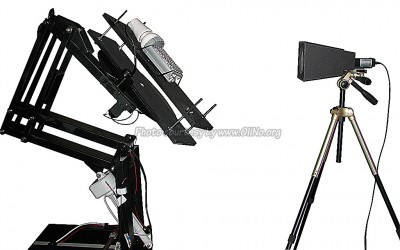
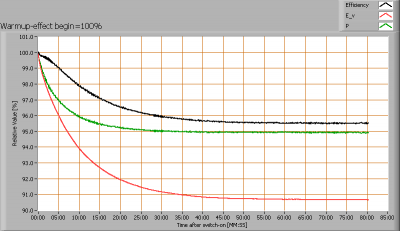
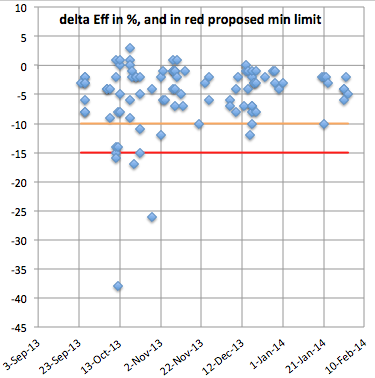
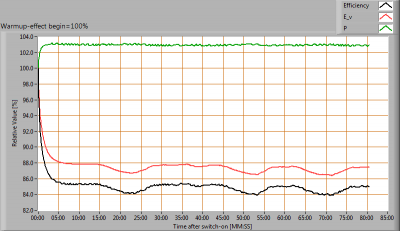
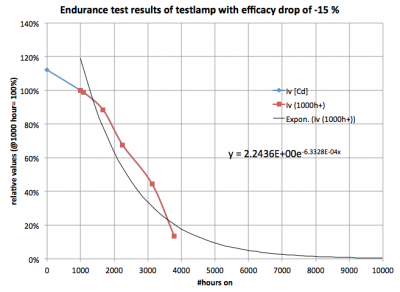
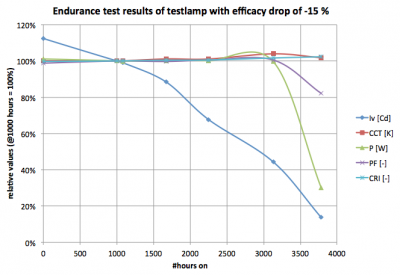





1 reply on “Endurance LED bulb and relation to warmup measurement”
I’ve been using UV protection films from https://www.tintfit.com/shop/uv-protection for a while now, and I’m really impressed. They’ve made a noticeable difference in reducing sunlight glare and preventing fading on my carpets and furniture. They’re also great for keeping the temperature comfortable indoors.